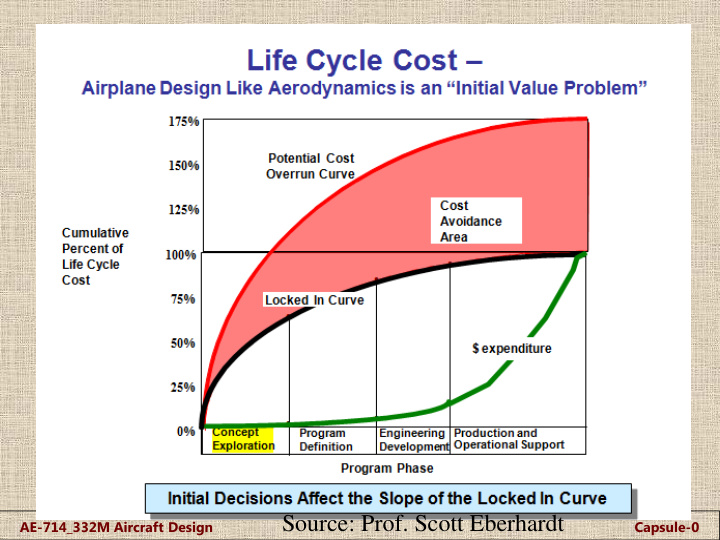



Source: Prof. Scott Eberhardt AE-714_332M Aircraft Design Capsule-0
Cost is the Key ! Needs to be established very early in design Paradigm shift in Aircraft Design ‘Performance at any cost’ 1940 ‘Design-to-cost’ 1970 ‘Design-to-LCC’ 2000 Requirements drive cost Requirements always creep Costs increase Classic examples: B-2, F 22, F-35, …. AE-714_332M Aircraft Design Capsule-0
The Conceptual/Preliminary “Design Process” “ A problem properly posed is half solved” Design Resources Requirements (“musts”) & Objectives (“wants”) Systems Manufacturing Meets DR&Os ?? Trade Studies Controls The Other Integration & Design external Software factors Testing Propulsion Yes ! Proceed Aerodynamics No ! Structures What would happen Reject ? if: or • Requirements change Marketing • Constraints change • Assumptions change Source: Prof. Scott Eberhardt AE-714_332M Aircraft Design Capsule-0
The Design Spiral Increasing Understanding Synthesis Analysis Decisions Radius of Spiral Suggests Range of Feasible Choices Source: Introduction to Aeronautics: A Design Perspective , Brandt, Stiles, Bertin, Whitford, 2 nd ed., AIAA Education Series, 2004
Aircraft Development Process Performance Mission Conceptual Design & Cost Goals Requirements Computational Preliminary Design Wind Tunnel Testing Flow Simulations Detailed Design & CAD / CAM Manufacturing Computational Flight Testing Flow Simulations Production AE-714_332M Aircraft Design Capsule-0
Aircraft Conceptual Design Process Requirements Technology Concepts General Layout Modified Layout Initial Sizing & Layout Cost Estimation Aerodynamics Preliminary Design Propulsion Structures Mass Estimation Landing Gear Refined Sizing & Performance Optimization Sizing & Performance Optimization Source: Aircraft Design, A Conceptual Approach, Dan Raymer, 4 th Ed. AIAA Education Series, 2006 AE-714_332M Aircraft Design Capsule-0
Beginning Conceptual Design Jet engine powered Or, propeller? Source: Prof. Scott Eberhardt AE-714_332M Aircraft Design Capsule-0
Conceptual Design Land based Or, amphibian? Source: Prof. Scott Eberhardt AE-714_332M Aircraft Design Capsule-0
Conceptual Design Wing mounted engines Or, tail mounted? Source: Prof. Scott Eberhardt AE-714_332M Aircraft Design Capsule-0
Requirements Capture
What is Requirements Capture ? Understanding exactly what the Customer wants Understanding the priorities of Customer’s needs Identifying the features in the design that will help in meeting these needs result in highest customer satisfaction Comparative analysis of competitor's designs identifying areas where they are better/superior identifying areas of superiority & leadership identifying areas offering scope for improvement
Part of First US Military Airplane Specifications Source: Prof. Scott Eberhardt AE-714_332M Aircraft Design Capsule-0
Typical Design Requirements : MJF PARAMETER REQUIREMENT Combat Mission Radius 400 nm Weapons Payload 2 AIM-120, 4 x 2000 lb MK-84 600 rounds 20 mm ammunition Takeoff Distance 2,000 ft Landing Distance 2,000 ft Max Mach Number M = 1.8 at optimum altitude at Wman a 18 deg/sec at M = 0.9, 20,000 ft MSL b at Wman Instantaneous Turn Rate P s 800 ft/sec, M = 0.9, 5,000 ft MSL at Wman Sustained g 4-g at M = 1.2, 20,000 ft MSL at Wman 9-g at M = 0.9, 5,000 ft MSL at Wman a. The maneuver weight (Wman) is the aircraft weight with 50% internal fuel, two AIM-120 AMRAAM missiles, and full cannon ammunition, but no air-to-ground weapons . b. The abbreviation MSL signifies altitude above mean sea level, the average elevation of the Earth’s oceans AE-714_332M Aircraft Design Capsule-0
Typical Mission Profile: MJF AE-714_332M Aircraft Design Capsule-0
Multirole Jet Fighter Aircraft AE-714_332M Aircraft Design Capsule-0
Different for different types of aircraft DESIGN CONSIDERATIONS AE-714_332M Aircraft Design Capsule-0
Recommend
More recommend